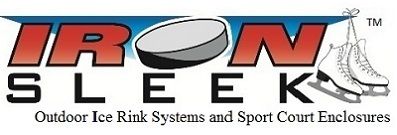Selecting Ice Rink Liner
Our ice rink liners are a single polyethylene sheet, pin-hole free, seamless, multilayered, and white. White liners make a big difference for forming and keeping ice on your rink. White liners will help keep the ice from melting by reflecting radiant heat away from the rink on sunny winter days. Iron Sleek manufactures our ice rink liners using virgin polyethylene resins - never recycled. Our multilayered liners are much stronger than most other ice rink liners.
Some lower cost options that can be found at the local hardware store may be made of recycled materials since they are not specifically made for winter ice rinks. The first resin melt produces the highest quality plastic which is required to absorb the abuse of a cold winter. Our manufacturing recipe for liners is proven for outdoor rinks while recycled solutions are a compromise.
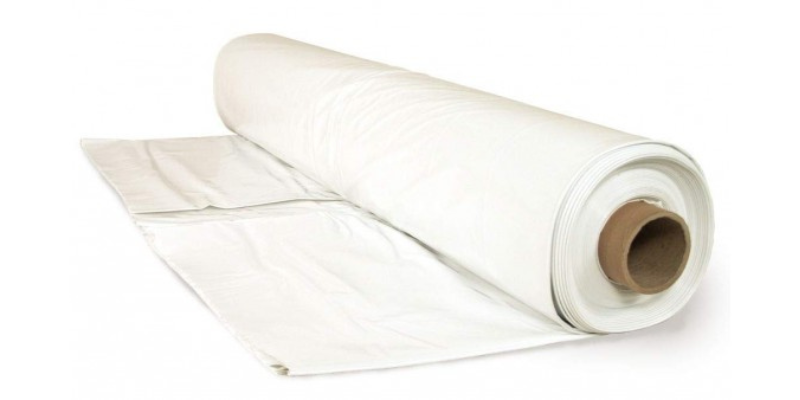
What Are The Benefits Of Using An Ice Rink Liner?
Rink liners are the best way to build a successful outdoor rink. When the goal is to build a great rink for yourself or your community that will last and be worth the effort and money, the liner method is the answer. Below are some reasons to use a liner versus flooding the grass, asphalt, or concrete.
Easier Set-Up
It will take countless hours in the freezing cold to build up ice without a liner. With a liner, it is as easy as frame, fill, and freeze. Frame the rink with your boards, fill your liner with water, and wait for the cold to freeze. After you fill the rink, it is hands off.
Longer Skating Season
Without a liner, rink builders must wait until they have cooperative weather to build their rink. An unlined rink built too early could end up being a total waste when you are counting on cold weather to freeze the ground. On the other hand, with the liner method, there is little risk of wasted work and wasted water for an early season start. The frame can be built in advance in the late fall. The liner will contain the rink water during thaws and reflect sunrays away from the rink. With a liner, you can start skating in late November and skate as late as early March depending on what region you live in.
Reduced Maintenance
A lined rink withstands freeze/thaw scenarios with ease. A thaw actually improves the rink surface as the water finds its own level and naturally smooths itself out. When the cold comes back, it could take as little as a single evening to the have the rink back up and running. Without a liner, a thaw can mean that you will need to start over because water will drain away through the lawn. Without a liner, it can take several freezing cold nights, lots of excess water, and countless hours to get back to skating.
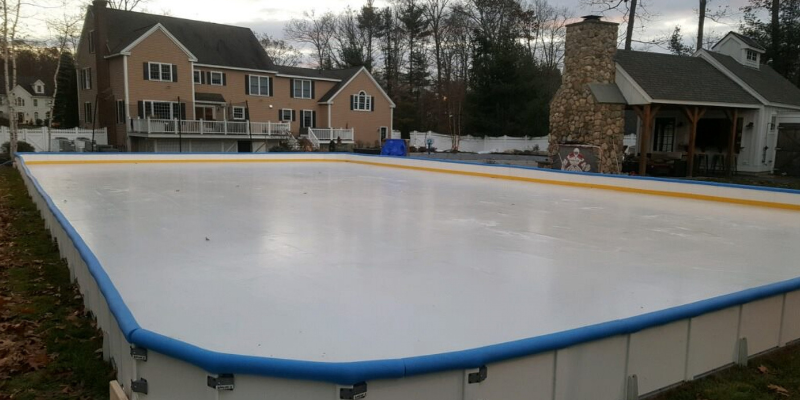
Cost Savings & Ice Quality
Water can be expensive. A small residential rink takes as little as 5000 gallons of water to fill while a larger community rink could take over 100,000 gallons. Without a liner, water can seep away into the lawn on warmer days. With a liner, it takes just one fill up. Besides the cost in water, the cost of maintaining the top surface is much more involved without a liner. As rink water washes away, the top surface has to be continually rebuilt. With a liner, water does not flow away so it just takes minutes to apply a minimal top coat of resurfacing water.
Site Does Not Need To Be Level
Granted, a level site is always better for building an outdoor rink, but it is not as critical if you are using a liner. If you have less than 12 inches of pitch, do not bother leveling the site. Without a liner, it is nearly impossible to build up an ice surface on the lawn with significant pitch. Water will always find its level. This is a battle that can never be won - except with a liner where you can compensate for unlevel ground by using taller boards where the water is deeper.
Preserves Your Lawn
Flooded lawns in the winter are not good for grass roots. Many rink areas where a liner is not used leave a partially or fully destroyed lawn. In most cases, a liner preserves the lawn. If the liner is laid after the grass is dormant and removed before it becomes active, the grass usually comes back healthier and stronger. Consider a golf course - they cover their greens.
Preserves Asphalt & Concrete
Asphalt and concrete are the first surfaces to melt snow or ice because they absorb and hold heat better than lawns. On a snowfall day, the grass will hold the snow first and then the streets and parking lots will follow. Some rink builders approach this challenge by chalking the blacktop or concrete to make the surface white before flooding the rink area. Chalking is a messy method and it is not all that effective in the long run - the chalk eventually bunches up under the ice and leaves melting spots.
Liners work great on asphalt and concrete too because the white surface helps with keeping the stone surface cool and it is essential to keep water out of even the smallest of stone cracks. Water that freezes into concrete or blacktop cracks will eventually destroy a porous surface. With a liner, the ice rink will be much improved by keeping the pavement cool and protected from the negative effects of ice formations and thaw in stone cracks.
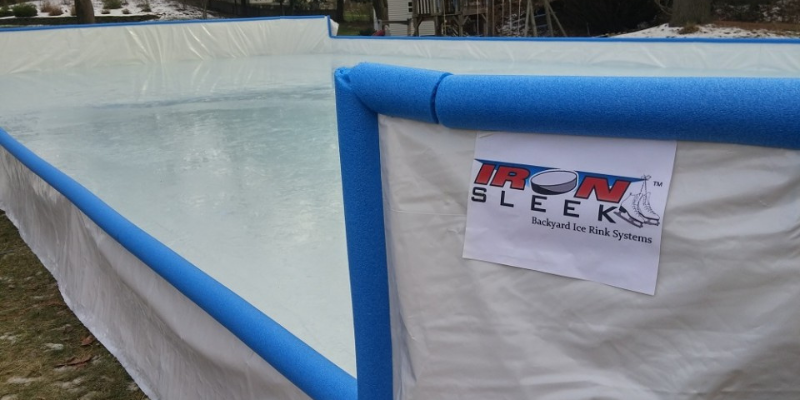
How Thick Should My Ice Rink Liner Be?
The word "mil" refers to the thickness of a particular liner in thousands of an inch. We recommend using a 6 mil liner for your rink. Winter freeze and thaw patterns cause ice rinks to creep throughout the season, while a 3 mil liner is impermeable, it is too thin to endure numerous freeze/thaw cycles. 6 mil is the best option for the majority of rink builders. If you have rocky or rough terrain, our string reinforced liner may be a better solution for you.
What Size Liner Do I Need?
Minimally, a liner should be big enough to cover the entire skating surface and should be able to come all the way up the boards and then droop down a bit on the exterior. The liner should be at least 5 feet wider and 5 feet longer than the size of your rink. For example, a rink that is 30' x 50' should use a liner that is at least 35' x 55'. It is always good to have extra liner just in case you need to use taller boards. Use our rink topper to hold the liner in place and to give your rink a classic hockey rink look. Liner clips are an affordable alternative to rink topper.
Can I Reuse My Ice Rink Liner?
It is best to purchase a new liner every year. While our ice rink liners are reusable, it is generally not worth the headache of storing your liner and having to worry if it was torn during removal or storage. Keep it simple - invest in a new liner every year. You can use your old liner as a cover for lumber or anything else that you may need. If you do save your liner, you can also use it as an extra bottom layer for your rink.
Do Ice Rink Liners Kill Grass?
Liners should be laid down right before a deep freeze is coming. By that time, the grass is already dormant. Snow covered grass gets little to no sunlight and grass still comes back every year. The problem occurs when you leave your liner in place during the time your grass becomes active. If you lay your liner down on dormant grass and take it up when the grass is still dormant, your grass will be fine. Obviously, the weather cannot be controlled and a fluke season could happen where the grass could become active before your liner is up. All in all, the risk of your liner killing your grass is minimal when set-up and take-down happens in a timely manner.
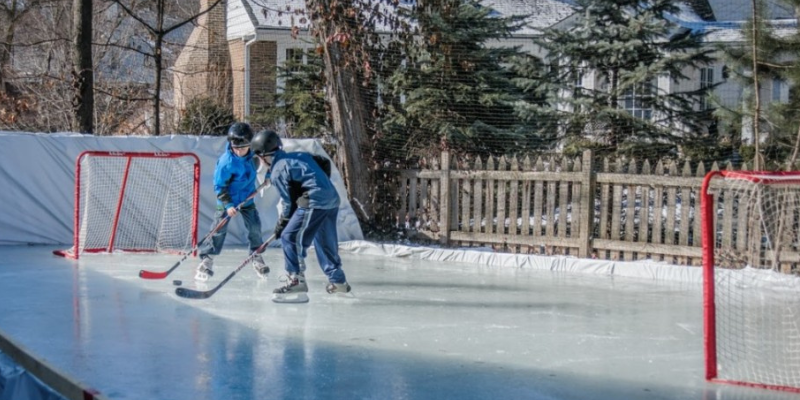
Save Yourself Time & Effort - Use A Liner
Treat your liner very carefully when installing it. Be sure that nothing sharp is in your rink area or on your boards. Be sure that no screws are pointing into the rink interior. Tuck your liner down snugly into the rink. Fill the bottom gaps with soil or use base cove. Do not staple your liner until it is settled when the rink is full of water. Rink topper is a great alternative to stapling. Never walk on your liner.
Winter comes around only once a year. There is only one opportunity to build a rink correctly. People have been building rinks with liners for decades. Use what is proven and avoid the exhaustion of saturating and coating the frozen ground. Flooding the lawn or pavement will leave you exhausted and disappointed. Please call us at any time to discuss your rink enclosure or if you have any questions regarding ice rink liner.
